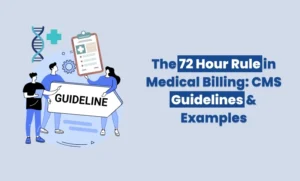Medical billing for dermatology isn’t just paperwork; it’s the financial engine behind your practice. Whether you’re handling everything in-house or working with third-party experts, navigating insurance requirements, CPT codes, and denial management can be overwhelming. That’s where specialized dermatology medical billing services come in. They don’t just simplify operations; they protect your revenue and your reputation.
In this guide, we’ll walk you through everything from coding best practices to insurance coverage rules, helping you streamline your billing process and get paid faster, with fewer headaches.
What is Dermatology Medical Billing and Coding?
Dermatology medical billing and coding involves translating clinical procedures into standardized codes used by insurance payers to process and reimburse claims. These codes include:
- CPT (Current Procedural Terminology): Describes the procedure performed.
- ICD-10 (International Classification of Diseases): Represents the diagnosis.
- HCPCS (Healthcare Common Procedure Coding System): Covers supplies, drugs, and services not included in CPT.
Because dermatologists often perform multiple services in one visit (e.g., a biopsy and excision), coders must use bundling rules correctly. Even one misstep, like submitting a cosmetic mole removal as a medical necessity, can lead to denied claims or compliance issues.
Proper coding supports:
- Timely reimbursements
- Accurate patient billing
- Compliance with insurance guidelines
Common Dermatology Billing Guidelines
Mastering dermatology billing starts with understanding and applying the right guidelines. Here are key areas to focus on:
Distinguishing Medical vs. Cosmetic Services
Insurance typically only pays for treatments deemed medically necessary. For example:
- ✅ Covered: Excising precancerous lesions
- ❌ Not Covered: Removing benign moles for appearance
Using Modifiers Appropriately
Modifiers are critical in dermatology claims to clarify the scope and context of the procedure:
- Modifier -25: For significant, separately identifiable E/M services on the same day
- Modifier -59: For distinct procedural services
Avoiding Common Errors
- Upcoding or under coding services
- Failing to support claims with documentation
- Missing time-based coding for phototherapy or complex wound care
Staying Updated
Codes and billing rules evolve annually. Using outdated codes can immediately result in claim denials. Subscribing to specialty-specific updates or working with expert billing partners helps maintain compliance.
Challenges in Dermatology Medical Billing
Even experienced dermatology practices face billing headaches. Here are common roadblocks:

1. High Denial Rates for Cosmetic Services
Insurers are quick to deny claims they deem cosmetic. If clinical notes don’t support medical necessity, payment will likely be rejected.
2. Complex Coding Requirements
Procedures like biopsies, excisions, and lesion removals must be billed using precise CPT codes, often with modifiers. Incorrect coding or mismatched diagnosis codes can result in delays or denials.
3. Inadequate Documentation
Without detailed documentation (e.g., lesion size, location, pathology report), claims lack the justification needed for approval.
4. Payer-Specific Rules
Each insurance company has its own rules for bundling, prior authorization, and modifier use. Keeping track of these nuances requires time and expertise.
Dermatology Medical Billing Services: Why They Matter
Professional dermatology medical billing services help eliminate errors, reduce rejections, and optimize revenue. These services specialize in dermatology-specific billing rules and payer nuances, giving practices more time to focus on patient care.
Outsourcing to a specialized team can result in:
- Up to 30% faster claims processing
- Up to 25% reduction in denials
- Improved compliance and fewer audit risks
What They Typically Offer:
- Accurate charge entry and claim submission
- Insurance verification and authorization
- Denial analysis and appeal processing
- Payment posting and patient billing support
- Reporting and analytics for practice performance
Why It Matters for Your Practice
Every denied or delayed claim affects cash flow. Outsourcing to dermatology billing experts means:
- Fewer billing errors
- Stronger documentation support
- Better reimbursements with less effort
Whether you’re a solo practitioner or a multi-location dermatology group, investing in billing expertise can make or break your bottom line.
Dermatology Revenue Cycle Management (RCM)
Effective revenue cycle management (RCM) is the backbone of a financially healthy dermatology practice. It involves managing the entire patient payment process from appointment scheduling and insurance verification to claim submission, denial management, and final reimbursement.
Key Components of Dermatology RCM:
- Pre-authorization and eligibility checks
Confirm coverage before procedures are performed. - Accurate coding and billing
Ensure CPT and ICD-10 codes reflect the actual services rendered. - Timely claims submission
Avoid missed deadlines and delays in cash flow. - Denial resolution and follow-ups
Appeal denials promptly and correct errors fast. - Patient collections
Communicate clearly with patients about balances, co-pays, and insurance coverage.
Why Dermatology RCM Is Unique
Dermatology often involves repeat visits, multiple procedures in a single session, and a mix of covered vs. non-covered services. This makes dermatology revenue cycle management more complex than many other specialties.
Partnering with an RCM provider who understands these nuances ensures you maximize reimbursements and minimize administrative friction.
Insurance Coverage for Dermatology Procedures
Insurance coverage in dermatology comes down to medical necessity. If a procedure is performed to diagnose, treat, or prevent a medical condition, it’s likely covered. If it’s for aesthetic purposes only, it probably isn’t.
Typically Covered Procedures:
- Skin cancer screenings and treatment (e.g., Mohs surgery)
- Biopsies of suspicious moles or lesions
- Psoriasis, eczema, and rosacea management
- Acne treatment (severe cases)
- Cryotherapy for warts or actinic keratosis
Typically Not Covered:
- Cosmetic mole or tattoo removal
- Botox or fillers for aesthetic purposes
- Laser treatments for hair removal or skin rejuvenation
- Chemical peels and microdermabrasion for aging
Best Practice:
Always verify insurance coverage and obtain prior authorization when needed. Explain costs and potential out-of-pocket expenses to patients upfront to avoid disputes later.
Final Thoughts
Investing in specialized dermatology billing services or partnering with an experienced RCM provider not only ensures you get paid faster but also frees up your time to focus on what matters most: your patients.If you’re ready to eliminate billing headaches and boost your practice’s profitability, consider reaching out to a trusted billing partner like RevenueES Dermatology Billing Services to get started.





